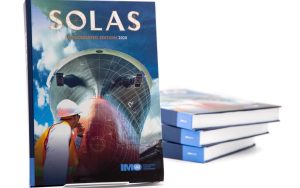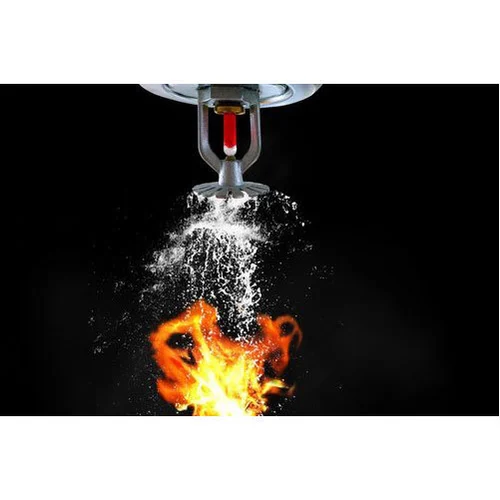In the realm of maritime safety, fire hazards present a significant risk to both the vessel and its crew. Commercial ships, particularly those with sizable accommodations, require advanced fire suppression systems to safeguard lives and property. One of the most widely adopted safety measures on board is the fixed fire fighting sprinkler system, specifically designed to protect the accommodation spaces of commercial vessels.

Components of a Fixed Sprinkler System and How the System Works?
Fires at sea pose an extreme danger, with limited escape routes and challenging environmental factors like wind and weather. In accommodation areas where crew members live, sleep, and work, fires can spread rapidly, fueled by furnishings, personal belongings, and electrical systems. Fixed fire fighting sprinkler systems act as the first line of defense, offering immediate response to fire outbreaks and minimizing the potential for disaster.
A typical fixed fire fighting sprinkler system onboard ships consists of several key components:
- Sprinkler Heads: These are heat-sensitive devices installed in ceilings and walls. They are designed to activate when a certain temperature threshold is reached, allowing water to be released directly onto the fire-affected area.
- Piping Network: A network of pipes connects the sprinkler heads to a pressurized water source. The piping extends throughout the accommodation areas to ensure comprehensive coverage.
- Water Supply: The water supply system is typically connected to the ship’s fire main, a high-pressure system designed to deliver a continuous supply of water in the event of an emergency.
- Control Valves and Pumps: Control valves regulate the flow of water, while pumps ensure consistent pressure is maintained throughout the system, even in challenging sea conditions.
When a fire is detected in an accommodation area, the fixed sprinkler system is triggered automatically by the heat generated from the fire. Sprinkler heads are individually heat-activated, ensuring that only the heads nearest to the fire are triggered, thus localizing the response and preventing unnecessary water damage to other parts of the accommodation. Upon activation, the sprinkler heads release water at high pressure, suppressing the fire by cooling the flames and preventing the fire from spreading. This rapid response buys crucial time for the crew to take additional action, such as initiating the ship’s broader fire suppression protocols, deploying firefighting teams, or evacuating the affected area.
Regulatory Standards and Compliance

The installation of fixed fire fighting sprinkler systems in the accommodation areas of commercial ships is governed by international regulations. The International Convention for the Safety of Life at Sea (SOLAS) sets out strict guidelines for fire safety equipment, including sprinkler systems. According to SOLAS, commercial vessels must have fire suppression systems that are capable of operating under all expected environmental and operational conditions.
In addition, the International Maritime Organization (IMO) provides further guidelines on the design, installation, and maintenance of fixed fire fighting systems onboard ships. These guidelines emphasize the importance of routine inspections, testing, and maintenance to ensure that the system remains operational at all times.
Benefits of Sprinkler Systems in Accommodation Spaces
- Automatic Activation: One of the greatest advantages of fixed fire fighting sprinkler systems is their automatic activation. Unlike handheld extinguishers, which require manual intervention, sprinklers activate on their own, offering an immediate response to fire outbreaks.
- Localized Fire Suppression: By targeting the exact area of the fire, the sprinkler system minimizes water damage to unaffected parts of the accommodation. This localized approach ensures that only the sprinklers nearest the fire are activated, preserving other areas.
- 24/7 Protection: Sprinkler systems provide round-the-clock protection, even when crew members are sleeping or away from the affected area, significantly reducing the risk of uncontrollable fires.
- Minimization of Fire Damage: Rapid suppression of a fire can prevent the blaze from spreading to other parts of the ship, reducing overall damage and ensuring that vital operations can continue without significant interruptions.
Types of Fixed Fire Fighting Sprinkler Systems
There are two primary types of sprinkler systems commonly installed on commercial ships: wet pipe systems and dry pipe systems. Each is designed to function under specific conditions.
- Wet Pipe Sprinkler Systems:
- How it works: In this system, the piping network is constantly filled with pressurized water. When the sprinkler head is triggered by heat (typically around 68-79°C, depending on the type), water is immediately discharged through the sprinkler heads to suppress the fire.
- Application: Wet pipe systems are most commonly used in accommodation areas and other parts of the ship where temperatures remain above freezing. This system is favored for its simplicity, reliability, and rapid response time since water is already present in the pipes.
- Dry Pipe Sprinkler Systems:
- How it works: In dry pipe systems, the pipes are filled with pressurized air or nitrogen instead of water. When a sprinkler head activates, the air pressure is released, allowing water from a central reservoir to flow into the piping network and then to the sprinklers. The delay in water discharge (due to the time taken to release air and fill the pipes with water) makes this system suitable for colder areas where pipes could freeze.
- Application: This system is ideal for areas of the ship exposed to low temperatures, such as cargo holds or deck areas, but it can also be installed in accommodation areas in colder climates.
Operation of the Sprinkler System
The operation of fixed fire-fighting sprinkler systems can be broken down into a few critical stages:
Heat Detection and Activation: Each sprinkler head has a heat-sensitive component, usually a glass bulb filled with a liquid that expands as it heats. When the liquid expands enough due to the heat from a fire, the bulb shatters, triggering the sprinkler. The sprinkler head is designed so that only those closest to the fire will activate, preventing unnecessary activation throughout the ship.
Water Discharge: In a wet pipe system, water is released immediately once the sprinkler head is triggered. In dry pipe systems, there is a slight delay as air is released and water flows into the pipes before being discharged. The sprinkler distributes water in a specific spray pattern to cover the maximum possible area while focusing on the fire’s origin. The water not only suppresses flames but also cools the surrounding area, reducing the likelihood of re-ignition.
Alarm System: Simultaneously, the activation of a sprinkler system triggers the ship’s fire alarm system, notifying the crew and fire control teams of the fire. Many modern ships also have systems that automatically report the location of the activated sprinkler to a central control room, helping emergency teams locate the fire quickly.
Manual Override: Ship crews have the ability to manually override the system via control valves. This is critical for maintenance or in cases where an automatic activation is unnecessary or unwanted.
Challenges and Maintenance
Despite their efficacy, fixed fire-fighting sprinkler systems must be properly maintained to remain fully operational. Saltwater corrosion, blockages in the pipes, and degradation of the sprinkler heads are common issues that require regular inspection and servicing. Crews must be trained to recognize the signs of malfunction and report any concerns to the ship’s maintenance team. Periodic system testing is essential to ensure that the sprinklers will function correctly in an emergency. In addition to routine checks, ships must also comply with the inspection intervals set by IMO and SOLAS standards, which often require annual testing and certification of the fire suppression system.
Fixed fire-fighting sprinkler systems are a vital component of fire safety on commercial ships, particularly within accommodation spaces. Their automatic response, combined with efficient and localized suppression capabilities, make them indispensable in preventing fires from escalating into catastrophic events. Compliance with international regulations, proper maintenance, and regular testing ensure these systems continue to safeguard crew members and vessels from the dangers of fire at sea. By investing in modern sprinkler systems and ensuring they are well-maintained, shipowners can provide a safer environment for their crews and reduce the risks associated with maritime fires.

